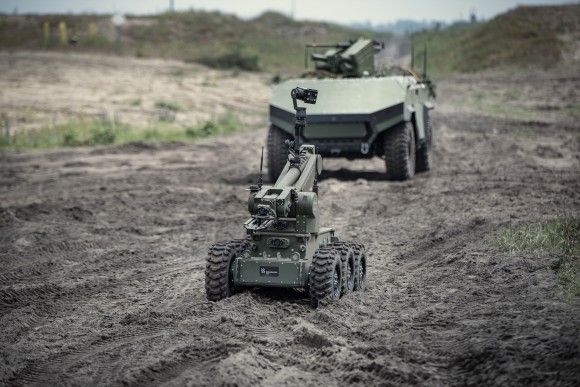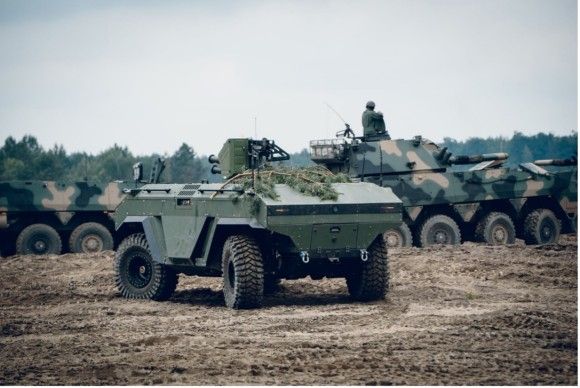Technology
Polish HUNTeR Armed UGV - Field Tested

Photo. Anna Jurczak/Łukasiewicz-ŁIT
Many countries are currently engaged in programmes aimed at commissioning UGVs. Not only is the technology being tested, but the assumptions behind tactics, and the use of such platforms in sync with troops and manned systems are also being developed. The Polish Army has been recently engaged in a test programme regarding a Polish UGV - with the FEX event taking place in Nowa Dęba.
The significance of unmanned systems in the development of the Armed Forces is growing - this includes land platforms. This has been proven by the fact that a plenipotentiary has been appointed by the head of the Polish MoD, back in September 2021, to handle the matters tied to unmanned systems for the military. The function above was assigned to the current head of the Armament Agency, Brig. General Artur Kuptel Ph.D. On the other hand, the currently used land robots, operated by the Armed Forces, or the Uniformed Services, are limited to EOD/IED handling systems. The military EOD units frequently employ the RPP robots (Patrol-Portable Robot - Engineering Robot 1806 model). The Polish industry has the greatest know-how, regarding such designs - that especially applies to the Warsaw-based Łukasiewicz-PIAP company. And Łukasiewicz-PIAP has been successful in Poland, and abroad.

Photo. kpr. Sławomir Kozioł/WCR Świnoujście/Twitter
Interestingly, between 2008 and 2011 Poland decided to engage in a programme aimed at the development of an autonomous, universal tracked platform designed for combat and logistical tasks, meeting the standards of the modern battlefield. A prototype of a robotized transporter based on a modified 2S1 Gvozdika platform was developed back then. The system was an internal combustion-electric hybrid. As the military did not express any valid interest back then, the research programme was canceled. However, at the time this has been one of the first projects in that area, globally. Nowadays Poland needs to follow the lead of numerous nations engaged in UGV R&D or implementation - this includes combat testing.
Thus, the FEX (Field Experimentation Exercise) events organized in Nowa Dęba were very important for establishing the UGV capability. A new PIAP HUNTeR robot was presented there, equipped with the ZMU-03 RCWS (.50-cal. Machine Gun and a smoke grenade dispenser). This unmanned, armed ground vehicle is a result of a collaborative effort undertaken by the entities leading in the unmanned systems domain in Poland: Łukasiewicz-PIAP and AREX, a WB Group company.

For more than a week, the tactical capabilities of such a platform were tested, with the prospect of fielding UGVs, within the framework of the Polish General Staff's Future Task Force concept. The soldiers had a chance to get acquainted and assess the possibilities of using a wheeled reconnaissance UGV across a variety of tactical scenarios.
The first FEX organized by the Polish Armed Forces made it possible to present the PIAP HUNTeR system, and the ZMU-03 RCWS in operations reminiscent of actual, realistic scenarios, with an active role also played by other troops and fighting vehicles, such as the Rosomak APC.
Read more

Exercises as such constitute an invitation made by the Polish Armed Forces, to launch a dialogue between the commanders, and the technology providers, and to jointly engage in an effort aimed at developing common solutions, in the demanding modern battlefield scenarios.
PIAP HUNTeR is a Polish UGV design that may be used for border patrol and surveillance, surveillance of military or urban areas, and also for fire support purposes (working with the infantry), or to protect mechanized elements. The robot features a thermal imaging system, a TV camera, cameras used for movement, and a radio communications suite.
PIAP HUNTeR engaged in the FEX exercise featured the ZMU-03 RCWS fitted with a .50-cal. machine gun. The WB Group's AREX company is the manufacturer of the turret. Łukasiewicz-PIAP and AREX software developers integrated the RCWS with the robot's control panel. For the first time, the U-GATE system's capability to control the ZMU-03 station was demonstrated. U-GATE is a Personal Command and Observation System (Osobistego Systemu Dowodzenia i Obserwacji) developed by the WB Group. It was proven that the operator, using an AR solution, can carry out surveillance, designate targets, and engage them, using the RCWS.
Read more
The AREX ZMU-03 is a light turret system housing armament, and an EO system featuring a daytime camera, thermal imaging system, and a laser rangefinder. Optionally, the turret may also be equipped with a light UAV, such as X-FRONTIER. The module also includes a machine gun/EO system stabilizer, and a video tracker that may be used for targeted observation and precise engagements, also when the carrier platform is on the move. That system may be installed on a variety of wheeled platforms, but during the FEX event, it was its debut on a UGV.
PIAP HUNTeR weighs more than 4 tonnes. It is 4.7 meters long, 2.2 meters long, with a 2.2 meters wheelbase. The wheels have a diameter of 1 meter. The vehicle features dependent suspension (rigid), with three reaction rods, and a Panhard rod with screw springs and adjustable shock absorbers. The vehicle is powered by two electric motors. The Łukasiewicz-PIAP designers used a differential lock, and two turn-axles, which enhances the vehicle's offroad capabilities.
PIAP HUNTeR can travel at speeds of up to 50 kph, depending on the equipment and tasks assigned. The platform features six HD cameras: two for driving, and four for observing the outlining terrain. Furthermore, the ZMU-03's camera can also assist the operator when controlling the platform, and when conducting reconnaissance.
The electrical generator onboard powers the traction battery. The hybrid PSU system ensures long endurance and allows the UGV to move around covertly when solely the electric motors are used. The vehicle features disc brakes and parking brakes. The vehicle is controlled with the use of a portable control panel, also offering an option of connecting an extra display.
During the exercise, PIAP HUNTeR also worked with a heavy (320 kg) PIAP IBIS EOD robot. That robot can be controlled with the use of the HUNTeR's control unit, and it can be employed to support the surveillance efforts - with the use of its PTZ EO system, featuring a daytime/night camera, and a thermal imaging system. Radio control yielded over both robots, within a single network, allows for using the robots as a radio relay, which extends the operational range of either of the UGVs. Both vehicles also featured GPS (GNSS) systems, which allowed for displaying accurate position data via the onboard map unit, which also displayed the route covered. PIAP IBIS has also proven its high mobility on the terrain of the Nowa Dęba range.
Source: Press release issued by Łukasiewicz-PIAP/WB Group


